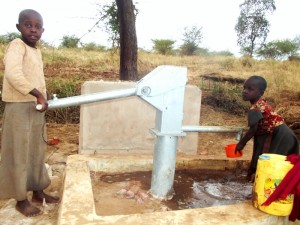This project is being implemented by our partner African Sand Dam Foundation, and includes the construction of a sand dam. Below is unedited project information direct from our partner:
Background information
The group was formed in September 2012. It has membership of 39 members 31 female and 9 male. The group is found in – sub-location of – location. The main reasons for forming the group were:
- The area had severe water shortage. Lack of water had led the area lagging behind in terms of development.
- The group wanted to improve the environment through soil conservation. By coming together they wanted to dig terraces that would conserve soil on their farms.
Economic activities
- Farming
- Livestock keeping
- Poultry keeping
Challenges to development
Water shortage
The main challenge that the community in the area faces is water shortage. The main water sources in the area are in River Syatu, River londokwe and River Miseke. River Miseke. River Londokwe is 4 kilometres and it takes 4 hours to fetch water from River Londokwe .In River Syatu in order to access water one has to dig deep scoop holes of more than four feet deep and during the dry period the water is salty hence used for livestock only. During the wet season the water is available. In River Londokwe 20 litre jerrican is sold at kshs 2 because it belongs to a self help group.
Women and children bear the burden of fetching water. In dry seasons of the year that is from August to November before the onset of rains school children are forced to come with water to schools nd those that don’t comply with such a rule are punished.This forces most children to miss school especially during the dry season inorder to fetch the water or also to avoid being punished.This has led to poor results from the children and drop out cases have been reported amongst the girl child. In most cases water brought to schools is not clean hence making the children vulnerable to water borne diseases. Women spent a lot of time in fetching water thus no time to do other household chores.
Due to lack of water in the area:
- More time spent in fetching water. Thus more efforts and resources are underutilised thus leaving community members languishing in poverty
- Tree planting. The lack of water has led to drying up of the trees making survival rate very low.
- Low incomes. Due to heavily relying on rain fed agriculture incomes continue to dwindle because of famine and drought and no alternatives for income generation,
Crop Production
The main types of crops that farmers grow include:
- Maize
- Cowpeas
- Sorghum
- Green grams
The climate has continued to change. Rains are no longer predictable as they used to. The area has not had rains for the last four years. This has caused high food shortage and strain on the available household resources. For coping most farmers have sold their livestock and other household assets in order to provide food whose average household size is 6 members. Apart from climate changes the other reasons for the reduced harvest in the area include
The main challenges to low harvests:
- Lack of seeds. Frequent droughts have affected the ability of community to preserve seeds for their planting needs. Due to this the farmers have reduced the size of land under farming.
- Pests and diseases. Increased pests and diseases have affected the farmers’ harvests. The farmers do not harvest as required due to post and pre harvest losses.
- Poor farming methods and practices. Most of the farmers farming methods and practices cannot enable them to have sufficient harvest. For example they grow maize and have reduced crop varieties. Lack of knowledge on farming methods has lead to low harvests
- Unreliable rainfall. Rainfall pattern have been a challenge because it is not predictable.
Environment conservation
Water shortages have inhibited planting of trees in the area. Apart from termite infestation also lack of knowledge have hampered tree planting. Other practices like clearing of trees to burn charcoal which is a subsidiary source of income have contributed heavily to destruction of vegetation cover.More areas formally under vegetation are being cleared to make room for farming land due to increasing population in the area. With all these uncontrolled practises coupled by the lack of knowledge, environmental degradation is at a higher rate.
Future plans
The community seeks to create water security through building of sand dams. The sand dam water will enable us to engage in horticultural farming, have water within our proximity and improve our income through selling of vegetables. Also we hope we shall have shallow wells across the river banks near the sand dams.
The community seeks to have knowledge and skills that will empower them to become climate resilience communities against climate change.
The community want to conserve the environment through terrace digging in their farms and planting trees. This will require them tools that will enable them to terrace their farms.
The community seeks to have seed bank where they can store there seed in order to curb this perennial problem of seeds in the area. They require seeds and tools that will enable them to terrace their terrace their farms and plant in their farms.
 Sand Dam
Sand Dam
 Rehabilitation Project
Rehabilitation Project



















